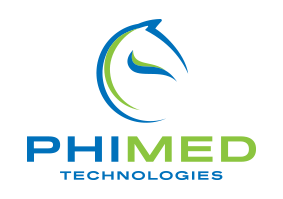
Artificial intelligence (AI) has become the buzzword that seemingly promises to solve every challenge in revenue cycle management (RCM) and medical billing. However, at PHIMED Technologies, we recognize that true innovation requires a more nuanced approach with powerful automation to deliver measurable results.
The Automation Ecosystem: More Than Just AI
While many vendors tout AI-only solutions, PHIMED has pioneered an integrated approach that recognizes the distinct but complementary roles of Artificial Intelligence (AI) and Robotic Process Automation (RPA). This fundamental distinction is at the heart of our philosophy: effective healthcare automation cannot rely solely on AI.
Understanding RPA’s Role in Medical Billing
Robotic Process Automation serves as the backbone of our automation strategy at PHIMED Technologies. Within the complex landscape of medical billing, RPA functions as digital workers that execute repetitive, rule-based tasks with 100% consistency. Unlike human operators who may experience fatigue or inconsistency, these automated systems perform identical operations with perfect precision every time, dramatically reducing error rates in routine billing processes.
The seamless integration of RPA into existing workflows represents one of its most valuable attributes for healthcare organizations. Rather than requiring extensive system overhauls or disruptive implementation periods, our RPA solutions replicate human actions within your current software environment. This means staff can maintain familiarity with existing systems while the digital workforce handles the repetitive aspects of their responsibilities, creating a harmonious partnership between human expertise and technological efficiency.
One of the most compelling advantages of RPA in medical billing is its capacity to process high volumes of predictable tasks around the clock. Medical practices generate thousands of billing transactions daily, creating bottlenecks when relying solely on human processing. Our RPA systems operate continuously, managing claim submissions during off-hours and ensuring that eligibility verifications proceed without interruption, regardless of time or staffing constraints. This continuous operation significantly reduces processing backlogs that plague many healthcare revenue departments.
In practical application, RPA handles numerous critical functions throughout the revenue cycle. From the initial patient registration process through claim submission, eligibility verification, and payment posting, these digital workers operate with remarkable efficiency. For example, when a claim requires submission, the RPA system can automatically extract relevant patient data, populate the appropriate fields in the claim form, verify coding accuracy against preset parameters, and submit the claim to the payer—all without human intervention. These digital workers operate within your existing systems, creating immediate operational improvements without requiring a complete infrastructure overhaul.
Despite these impressive capabilities, we at PHIMED maintain a realistic perspective about RPA’s inherent limitations. These automated systems function exclusively within predefined processes and parameters. They execute precisely what they are programmed to do—nothing more and nothing less. When encountering situations that fall outside their programmed parameters, RPA systems cannot improvise or make judgment calls as human operators would. For instance, if a payer introduces a new rejection code not previously encountered, the RPA system cannot independently determine how to respond without updated programming.
Additionally, RPA systems require human intervention for exceptions and edge cases that inevitably arise in healthcare billing. When claims are rejected for unusual reasons or when special circumstances apply to particular patient cases, human expertise becomes essential to navigate these complexities. Our approach acknowledges this reality by designing systems that efficiently escalate exceptional cases to appropriate human specialists, ensuring that unique situations receive the nuanced attention they require.
Perhaps most significantly, standalone RPA cannot independently adapt to new scenarios or evolving healthcare regulations. Unlike human workers who can read updated guidelines and adjust their processes accordingly, RPA systems cannot self-modify their programming to accommodate changes in the regulatory landscape or payer requirements. This inherent rigidity necessitates ongoing maintenance and updates, highlighting why RPA represents only one component of a comprehensive revenue cycle management strategy.
The PHIMED Difference: Integration, Not Isolation
What truly distinguishes PHIMED’s approach is our commitment to integrating these technologies rather than implementing them in isolation. Our proprietary framework creates a synchronized ecosystem where
This three-tiered approach delivers a comprehensive transformation of your revenue cycle management processes. By implementing RPA solutions at the foundation, you experience immediate efficiency gains as repetitive tasks are automated from day one, reducing processing times and eliminating backlogs that traditionally plague medical billing departments.
This three-tiered approach delivers a comprehensive transformation of your revenue cycle management processes. By implementing RPA solutions at the foundation, you experience immediate efficiency gains as repetitive tasks are automated from day one, reducing processing times and eliminating backlogs that traditionally plague medical billing departments.
Complementing these technological advantages, our expert human oversight provides the contextual understanding and nuanced decision-making that healthcare invariably demands, particularly when handling complex cases that require professional judgment and specialized knowledge of ever-changing regulatory landscapes.
Real-World Impact on Revenue Cycle Management
The practical benefits of this integrated approach manifest across the entire revenue cycle:
- Pre-Claim Submission
Our integrated system proactively identifies potential claim issues before submission, reducing the initial denial rate by up to 35%. The RPA components handle the verification processes.
- Claim Processing
During processing, our automation ecosystem tracks claims in real-time, with RPA managing the submission workflows, irregularities, and processing issues. This combination has reduced the average days in A/R by 21% for our clients.
- Denial Management
When denials do occur, our system automatically categorizes them, prioritizes based on value and collectability, and routes them to the appropriate specialists. This integrated approach has increased denial recovery rates by an average of 27%.
Beyond Technology: The Human Element
Perhaps the most important distinction in PHIMED’s approach is our recognition that healthcare revenue cycle management is fundamentally about patient care. While our technology drives efficiency, our teams ensure that each claim represents a patient’s healthcare journey.
This human-centered philosophy permeates every aspect of our technology development. We design our systems to enhance human capabilities rather than replace them, creating an environment where staff can focus on complex problem-solving and patient advocacy instead of repetitive tasks.
The Evolving Healthcare Revenue Landscape
As healthcare continues to evolve, PHIMED remains committed to refining our integrated approach. We continuously incorporate new technologies, adapt to changing regulations, and optimize our processes to ensure our clients maintain financial health in an increasingly complex environment.
The future of healthcare revenue cycle management is about intelligently orchestrating multiple technologies to create a system greater than the sum of its parts. At PHIMED Technologies, we’re proud to lead this revolution, delivering solutions that combine the best of artificial intelligence, robotic process automation, and human expertise.
When you partner with PHIMED, you’re not just implementing technology — you’re transforming your revenue cycle with a strategic approach designed for healthcare’s unique challenges.



